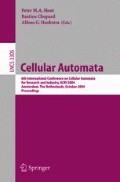Abstract
The Hybrid Cellular Automata (HCA) modelling framework can be an efficient approach to a number of biological problems, particularly those which involve the integration of multiple spatial and temporal scales. As such, HCA may become a key modelling tool in the development of the so-called integrative biology. In this paper, we first discuss HCA on a general level and then present results obtained when this approach was implemented in cancer research.
Access this chapter
Tax calculation will be finalised at checkout
Purchases are for personal use only
Preview
Unable to display preview. Download preview PDF.
References
Agur, Z.: Fixed points of majority rule cellular automata applied to plasticity and precision of the immune response. Complex Systems 5, 351–356 (1991)
Agur, Z.: Randomness, synchrony and population persistence. J. Theor. Biol. 112, 677–693 (1985)
Agur, Z., Arnon, R., Schechter, B.: Reduction of cytotoxicity to normal tissues by new regimens of phase-specific drugs. Math. Biosci. 92, 1–15 (1988)
Mehr, R., Agur, Z.: Bone marrow regeneration under cytotoxic drug regimens: behaviour ranging from homeostasis to unpredictability in a model for hemopoietic differentiation. BioSystems 26(4), 231–237 (1991)
Alarcón, T., Byrne, H.M., Maini, P.K.: A cellular automaton model for tumour growth in inhomogeneous environment. J. Theor. Biol. 225, 257–274 (2003)
Alarcón, T., Byrne, H.M., Maini, P.K.: A multiple scale model for tumour growth. SIAM Multiscale Modelling and Simulation (2004) (in press)
Artoli, A.M.M., Hoekstra, A.G., Sloot, P.M.A.: Simulation of a Systolic Cycle in a Realistic Artery with the Lattice Boltzmann. BGK Method, International Journal of Modern Physics B 17(1&2), 95–98 (2003)
Artoli, A.M.M., Hoekstra, A.G., Sloot, P.M.A.: Mesoscopic simulations of systolic flow in the Human abdominal aorta. Journal of Biomechanics (2004)
Brons, P.P.T., Raemaekers, J.M., Bogman, M.J., van Erp, P.E., Boezeman, J.B., Pennings, A.H., Wessels, H.M., Haanen, C.: Cell cycle kinetics in malignant lymphoma studied with in vivo iodeoxyuridine administration, nuclear Ki-67 staining, and flow cytometry. Blood 80, 2336–2343 (1992)
Couderc, B., Dujols, J.P., Mokhtari, F., Norkowski, J.L., Slawinski, J.C., Schlaifer, D.: The management of adult aggressive non-Hodgkin’s lymphomas. Crit. Rev. Oncol. Hematol. 35, 33–48 (2000)
Crampin, E.J., Halstead, M., Hunter, P., Nielsen, P., Noble, D., Smith, N., Tawhai, M.: Computational physiology and the Physiome project. Exp. Physiol. 89, 1–26 (2004)
Deutsch, A., Dormann, S.: Modelling of avascular tumour growth with a hybrid cellular automaton. Silico Biol. 2, 1–14 (2002)
Erlanson, M., Lindh, J., Zackrison, B., Landberg, G., Roos, G.: Cell kinetic analysis of non-Hodgkin’s lymphomas using in vivo iodeoxyuridine incorporation and flow cytometry. Hematol. Oncol. 13, 207–217 (1985)
Ermentrout, G.B., Edelstein-Keshet, L.: Cellular automata approaches to biological modeling. J. Theor. Biol. 160, 97–133 (1993)
Gatenby, R.A., Gawlinski, E.T.: A reaction-diffusion model of cancer invasion. Cancer. Res. 15, 5745–5753 (1996)
Kitano, H.: Systems biology: a brief overview. Science 295, 1662–1664 (2002)
Kitano, H.: Opinion: Cancer as a robust system: implications for anticancer therapy. Nat. Rev. Cancer 3, 227–235 (2004)
Lee, A.V., Schiff, R., Cui, X., Sachdev, D., Yee, D., Gilmore, A.P., Streuli, C.H., Oesterreich, S., Hadsell, D.L.: New mechanisms of signal transduction inhibitor action: receptor tyrosine kinase down-regulation and blockade of signal transactivation. Clin. Cancer Res. 9, 516S–523S (2003)
Lepage, E., Gisselbrecht, C., Haioun, C., Sebban, C., Tilly, H., Bosly, A., Morel, P., Herbrecht, R., Reyes, F., Coiffier, B.: Prognostic significance of received relative dose intensity in non-Hodgkin’s lymphoma patients: application to LNH-87 protocol. The GELA (Groupe d’Etude des Lymphomes de l’Adulte). Ann. Oncol. 4, 651–656 (1993)
Maree, A.F.M., Hogeweg, P.: How amoeboids self-organize into a fruiting body: Multicellular coordination in Dictyostelium discoideum. Proc. Nat. Acad. Sci. 98, 3879–3883 (2001)
McCulloch, A.D., Huber, G.: Integrative biological modelling in silico. In: Bock, G., Goode, J.A. (eds.) ’In silico’ simulation of biological processes. Novartis Foundation Symposium, vol. 247, pp. 4–19. John Wiley & Sons, London (2002)
Moreira, J., Deutsch, A.: Cellular automaton models of tumour development: a critical review. Adv. Complex Sys. 5, 247–267 (2001)
Murray, J.D.: Mathematical Biology. Springer, New York (2003)
Patel, A.A., Gawlinski, E.T., Lemieux, S.K., Gatenby, R.A.: A cellular automaton model of early tumour growth and invasion: The effects of native tissue vascularity and increased anaerobic tumour metabolism. J. Theor. Biol. 213, 315–331 (2001)
Ribba, B., Marron, K., Alarcón, T., Maini, P.K., Agur, Z.: A mathematical model of Doxorubicin treatment efficacy on non-Hodgkin’s lymphoma: Investigation of current protocol through theoretical modelling result. Bull. Math. Biol. (2004) (in press)
Ribba, B., Dahan, N., Vainstein, V., Kogan, Y., Marron, K., Agur, Z.: Doxorubicin efficiency in residual non-Hodgkin’s lymphoma disease: towards a computationally supported treatment improvement (in preparation)
Stokke, T., Holte, H., Smedshammer, L., Smeland, E.B., Kaalhus, O., Steen, H.B.: Proliferation and apoptosis in malignant and normal cells in B-cell non-Hodgkin’s lymphomas. Br. J. Cancer 77, 1832–1838 (1988)
Pries, A.R., Secomb, T.W., Gaehtgens, P.: Structural adaptation and stability of microvascular networks: theory and simulations. Am. J. Physiol. 275, H349–H360 (1998)
Wheng, G., Bhalla, U.S., Iyengar, R.: Complexity in biological signaling systems. Science 284, 92–96 (1999)
Willemse, F., Nap, M., de Bruijn, H.W.A., Holleman, H.: Quantification of vascular density and of lumen and vessel morphology in endometrial carcinoma. Evaluation of their relation to serum levels of tissue polypeptide-specific antigen and CA-125. Anal. Quant. Cytol. Histol. 19, 1–7 (1997)
Yancopoulos, G.D., Davis, A., Gale, N.W., Rudge, J.S., Wiegand, S.J., Holash, J.: Vascular specific growth factors and blood vessel formation. Nature 407, 242–248 (2000)
Author information
Authors and Affiliations
Editor information
Editors and Affiliations
Rights and permissions
Copyright information
© 2004 Springer-Verlag Berlin Heidelberg
About this paper
Cite this paper
Ribba, B., Alarcón, T., Marron, K., Maini, P.K., Agur, Z. (2004). The Use of Hybrid Cellular Automaton Models for Improving Cancer Therapy. In: Sloot, P.M.A., Chopard, B., Hoekstra, A.G. (eds) Cellular Automata. ACRI 2004. Lecture Notes in Computer Science, vol 3305. Springer, Berlin, Heidelberg. https://doi.org/10.1007/978-3-540-30479-1_46
Download citation
DOI: https://doi.org/10.1007/978-3-540-30479-1_46
Publisher Name: Springer, Berlin, Heidelberg
Print ISBN: 978-3-540-23596-5
Online ISBN: 978-3-540-30479-1
eBook Packages: Springer Book Archive

